One of the most memorable periods in British birdwatching history occurred just before and over the weekend, with an almost unprecedented fall of American land birds. Of particular interest to us was Britain’s third magnolia warbler, reported at St. Govan's Head aside the Stackpole Estate. There was also a melodious warbler nearby, and who knew what else ... still more might be found. There was even the offer of grey phalarope at Goldcliff Pools on the way home. However, every plan has a drawback - in this case it would be an early rise ready for a 3.00am departure. But it would be worth it for the opportunity to join our friend Nick Truby (@old_caley) who has visited the previous day and connected with both warblers.
Kev Heath (@kev07713) and I set off and enjoyed a smooth run all the way to St. Clears where we stopped for a breakfast, waiting 10 minutes for opening time. There was no time to waste and so it was very much a pit stop and we were back on our way with coffee in hand. We had a slight issue with the postcode as it left us quite distant from the car park, but we re-programmed the SatNav and it then dropped us right in the correct car park. We booted up and joined the birders looking for the magnolia warbler - more than 50 already there, but the bird had yet to be located ... it wasn't entirely clear which side of the white tape barrier the bird might appear, but odds were that it would be the sunny expanse of low scrub north of the car park. We scanned on both sides and waited.
Overhead choughs and ravens serenaded as they relocated at sunrise, and we waited for any sign - the magnolia warbler had gone to roost the previous night and people had been there, some overnight, and in place from before first light. It was likely to still be there …
The magnolia warbler is an extremely rare visitor from North America that breeds widely in the boreal forests of Canada. It was added to the British List following the finding of an individual on St Agnes, Isles of Scilly in 1981. Although it is small and very active, the Magnolia Warbler is not as difficult to observe as some warblers, because it often stays low in shrubbery and short trees. It forages by hopping along branches, gleaning insects from conifer needles, leaves, and twigs taking most insects from the underside of vegetation.
After about 45 minutes a shout went up - the bird was here and had been spotted in the bushes on the brow of the hill, on the sunny side as hoped. At least we wouldn't be looking into the sun. It had dropped down and it wasn't for another 15 minutes or so that the bird gave itself up to general view - tick, and 299 for the year for Kev. Having dropped down again it reappeared in a hawthorn bush to our right and I managed to see it as it dropped again, reappearing further behind by some honeysuckle flowers. It was lost again and I still didn't have a photo. The watching mass had now grown to what must be approaching 100 birders, now spread out around the expanse of scrub.
We then had some of our best views as the bird fed on the front side of a distant bush. Now I could get a photo although from distance - I should have followed Kev round but had stayed put where it had been seen last. Views now lasted for a few minutes rather than seconds, but I stayed put. There were then continued glimpses at distance, but the bird refused to come near enough for a closeup. Again, I should then have relocated to where Kev stood as the bird showed closer to him - I kicked myself and went to join him, spending the rest of our time on site there, waiting for the bird to show again. We'd wait another 30 minutes and then go and see if we could find the melodious warbler - the magnolia didn’t show again in this time.
We made for the car and as we did so, more and more people appeared to do the same - it became apparent that something was afoot ... a Canada warbler had just been reported 15 minutes along the coast. All those that had seen the magnolia were now on the move to catch what would be the UK's first Canada warbler - we'd struck lucky. The chap that had found the magnolia a few days before was apparently the finder of the Canada as well - amazing! The finder (Toby Phelps @phelpstoby1) was in place as we arrived in the first cohort, we all congratulated him. Now to relocate the bird ...
Canada Warblers are steely blue-grey above and bright yellow below, with an obvious whitish eye ring. The most noticeable feature is the broken black necklace across the chest - it lacks the striping along the flanks of the magnolia warbler we'd seen earlier. It moves rapidly, hopping and fluttering between branches in the undergrowth. Typically, it is found in low vegetation, especially wet woods and thickets, feeding on insects; usually up to 3 feet above ground. Sometimes hard to see in this dense cover, but it is said to be not especially shy, and a patient observer can usually get good looks. It is one of the longest-distance migrant warblers; winters in South America having relocated from the breeding grounds in the north.
Dozens of people were now in place and were searching around the area. As soon as anyone stopped for a look and spoke, the assembly relocated up and down the narrow lane - newly arriving cars attempting to pass the large number of bodies. It was mayhem. We searched for 45 minutes to an hour but eventually decided to go and see if we could find the melodious warbler as it been reported earlier - we could always come back if/when the bird was re-found.
We made the journey of just under an hour and found the car park easily. There were a handful of birders in position, but they reported that the bird had not been seen for a couple of hours - it had shown spectacularly well earlier and had been possible to watch it feed even without the use of bins. We set up and started scanning the low hedge it apparently favoured.
The melodious warbler is a scarce migrant to the UK in spring and autumn from its breeding grounds in south-western Europe; it winters in West Africa, from Gambia and Senegal, East to Nigeria and Cameroon. It is rather silent on passage but sings quite frequently in winter areas and around periods of arrival and departure. With autumn migration beginning in earnest this month, it's usually time to scrutinise passage warblers as they undertake the long journey south. Melodious warblers are arrive regularly in the UK, but in small numbers - they remain scarce enough to qualify as notable finds anywhere in Britain. It would be a lifer for both Kev and I.
A bird dropped out of view on the far edge of the hedge before any of us could get on it. In less than 10 minutes a bird hopped onto a stick to our right, picked up first by Kev. He called it out and asked if that wasn't what we were looking for - it was! - 300 for the year for. Kev, and what an achievement! In only a few tens of seconds it was gone and although we picked it up again as it worked right, it would soon go awol. Despite working up and down the hedge we would not find it again - the other birders had decided to leave and we did too, mainly because the Canada warbler had been found and was showing.
We arrived back at the copse where the Canada warbler had been reported earlier and were confused by the number of cars, but the lack of people. We parked the car and made our way back to find that the trees were full of people, all waiting to see the warbler. There must have been 75 or more people actually in the trees and lining the area where the bird had been spotted last. The only way we'd get a view was to join them.
Kev saw it first when a chap (Martin) called it when high in a tree at the back, 301 for Kev - I heard his call but couldn't pick out the bird - lacked the line that Kev got from standing beside him. It was a good half hour before I managed just a fleeting glimpse as the bird came up from the ground and into a low scrubby bush (and out of view) - just a second or two and no hope of a photo. People kept joining but instead of staying at the back they often pushed in front, blocking our view. It seemed unlikely that we'd get any better view as we were getting blocked from all angles - we hadn't been in a great spot before and viewing conditions were appalling. We left the copse and found Lee Evans going in the other way; he posted an update on Twitter of the situation we all found ourselves in. We then bumped into Alan Boddington (@alanbodd) who was finding the conditions challenging and decided to go and see the melodious for now.
We waited for a while but there was no let-up in the crowd, and so we headed for home. It was now too late to drop into Goldcliff Pools and so a grey phalarope would have to wait.
I'd gone to bed late after friends had visited for the evening, and so I didn't get up early. At about 8.45am my phone pinged away. I stretched out, picked up the phone and read that the Farmoor Reservoir grey phalarope was still there (had dropped in the previous day). I jumped out of bed, got dressed, grabbed a coffee from my machine and was on the road within 15 minutes. I pulled into the site finding there were not too many cars, and on the causeway could see that there were a handful of people with bins, scopes and cameras. They were presumably on the bird and as I approached, I could see Adrian Tysoe and Bryan Manston (@BryanManston) and then the phalarope on the water's edge. I was soon taking photos but after only a few minutes it took to the wing and relocated further down and further off the causeway.
Can there be a more beautiful bird that visits Oxfordshire? – this juvenile grey phalarope - about the same size as a starling for those that may not know. Records of this small Arctic visitor peak from mid-September through December. Normally occurring offshore but storm-driven individuals can also be found on large inland waterbodies such as Farmoor.
Gradually the bird swam back in to the edge and I managed a few photos before I had to leave - I hadn't had any breakfast yet and I'd been out all of the previous day. I walked back to the car with Adrian and caught up his news.
What a weekend it had been - four ticks, of which three were lifers. One a first and another a third UK record. This weekend will take some beating!


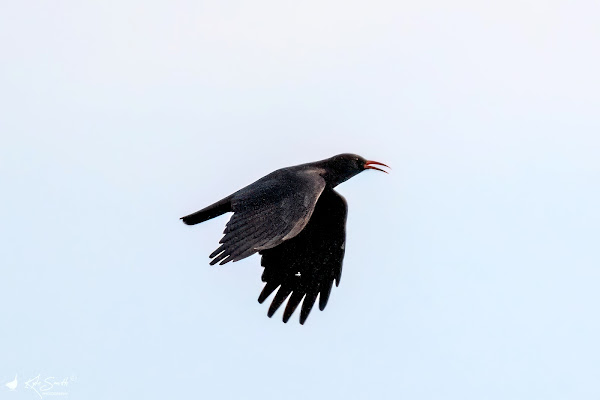
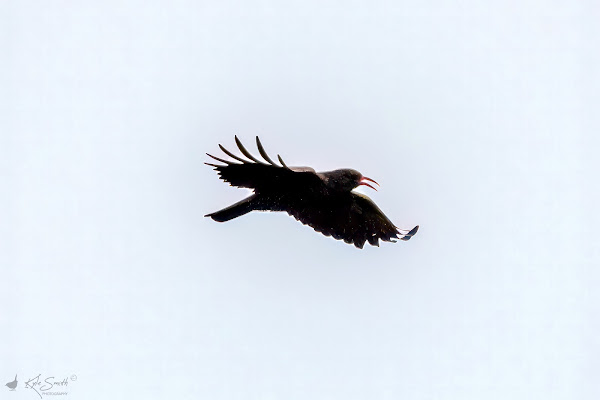
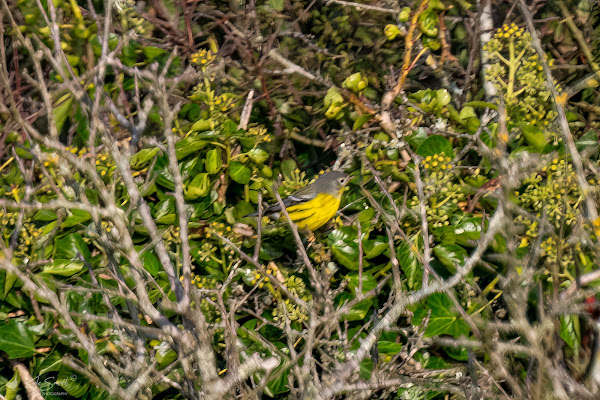



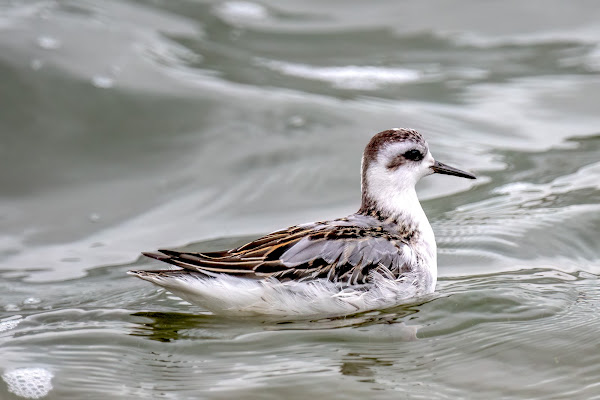

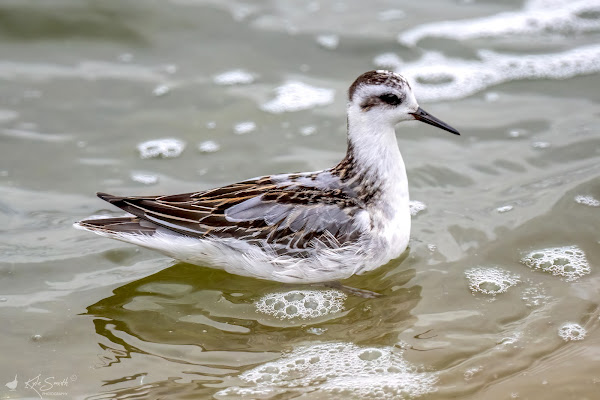
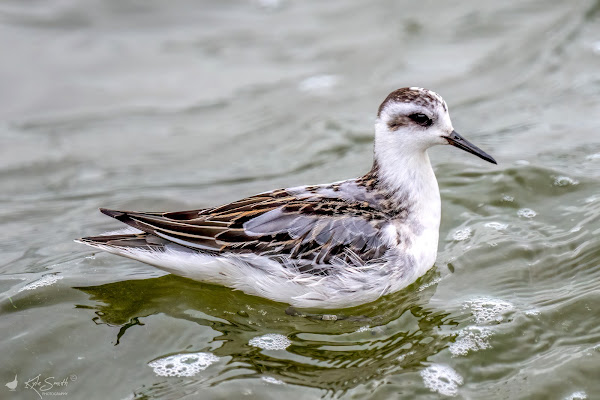
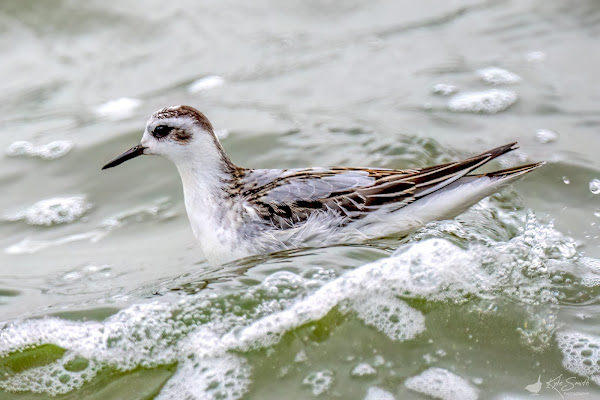
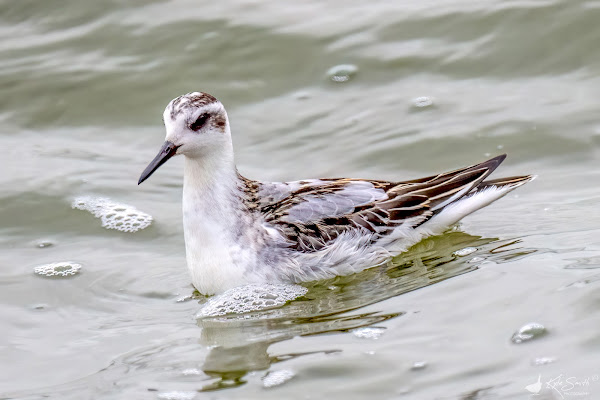
No comments:
Post a Comment